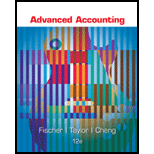
Advanced Accounting
12th Edition
ISBN: 9781305084858
Author: Paul M. Fischer, William J. Tayler, Rita H. Cheng
Publisher: Cengage Learning
expand_more
expand_more
format_list_bulleted
Question
Chapter 3, Problem 3B.1.3AE
To determine
Elimination and
Requirement of making such kind of entries is to eliminate the subsidiary share in the books of holding and also to record the transaction in the books of accounts.
To calculate:
Prepare consolidated worksheet for elimination and adjustments for the year end December
Expert Solution & Answer
Want to see the full answer?
Check out a sample textbook solution
Students have asked these similar questions
What is the unit variable cost ?
Financial Accounting Question need help
help this correct option
Chapter 3 Solutions
Advanced Accounting
Ch. 3 - Prob. 1UTICh. 3 - Prob. 2UTICh. 3 - Prob. 3UTICh. 3 - Prob. 4UTICh. 3 - Prob. 5UTICh. 3 - Prob. 6UTICh. 3 - Prob. 7UTICh. 3 - Prob. 1ECh. 3 - Prob. 2ECh. 3 - Prob. 3.1E
Ch. 3 - Prob. 3.2ECh. 3 - Prob. 3.3ECh. 3 - Prob. 3.4ECh. 3 - Prob. 3.5ECh. 3 - Equity method, second year, eliminations, income...Ch. 3 - Prob. 4.2ECh. 3 - Prob. 5.1ECh. 3 - Prob. 5.2ECh. 3 - Prob. 5.3ECh. 3 - Prob. 5.4ECh. 3 - Prob. 5.5ECh. 3 - Prob. 6.1ECh. 3 - Prob. 6.2ECh. 3 - Prob. 7.1ECh. 3 - Prob. 7.2ECh. 3 - Prob. 7.3ECh. 3 - Prob. 7.4ECh. 3 - Prob. 7.5ECh. 3 - Prob. 8.1ECh. 3 - Prob. 8.2ECh. 3 - Prob. 9ECh. 3 - Prob. 10.1ECh. 3 - Prob. 10.2ECh. 3 - Prob. 10.3ECh. 3 - Prob. 11ECh. 3 - Prob. 3B.1.1AECh. 3 - Prob. 3B.1.2AECh. 3 - Prob. 3B.1.3AECh. 3 - Prob. 3B.2.1AECh. 3 - Prob. 3B.2.2AECh. 3 - Prob. 3B.3AECh. 3 - Prob. 3.1.1PCh. 3 - Prob. 3.1.2PCh. 3 - Prob. 3.1.3PCh. 3 - Prob. 3.2.1PCh. 3 - Prob. 3.2.2PCh. 3 - Prob. 3.3.1PCh. 3 - Prob. 3.3.2PCh. 3 - Prob. 3.3.3PCh. 3 - Prob. 3.3.4PCh. 3 - Prob. 3.4.1PCh. 3 - Prob. 3.4.2PCh. 3 - Prob. 3.5.1PCh. 3 - Prob. 3.5.2PCh. 3 - Prob. 3.5.3PCh. 3 - Prob. 3.6.1PCh. 3 - Prob. 3.6.2PCh. 3 - Prob. 3.6.3PCh. 3 - Prob. 3.7.1PCh. 3 - Prob. 3.7.2PCh. 3 - Prob. 3.7.3PCh. 3 - Prob. 3.8.1PCh. 3 - Prob. 3.8.2PCh. 3 - Prob. 3.9.1PCh. 3 - Prob. 3.9.2PCh. 3 - Prob. 3.10.1PCh. 3 - Prob. 3.10.2PCh. 3 - Prob. 3.11.1PCh. 3 - Prob. 3.11.2PCh. 3 - Prob. 3.12.1PCh. 3 - Prob. 3.12.2PCh. 3 - Prob. 3.13.1PCh. 3 - Prob. 3.13.2PCh. 3 - Prob. 3.15.1PCh. 3 - Prob. 3.15.2PCh. 3 - Prob. 3.16.1PCh. 3 - Prob. 3.16.2PCh. 3 - Prob. 3.17.1PCh. 3 - Prob. 3.17.2PCh. 3 - Prob. 3.18.1PCh. 3 - Prob. 3.18.2PCh. 3 - Prob. 3A.1.1APCh. 3 - Prob. 3A.1.2APCh. 3 - Prob. 3A.2APCh. 3 - Prob. 3A.3APCh. 3 - Prob. 3B.1APCh. 3 - Prob. 3B.2APCh. 3 - Prob. 3B.3.1APCh. 3 - The trial balances of Campton Corporation and Dorn...Ch. 3 - The trial balances of Campton Corporation and Dorn...
Knowledge Booster
Similar questions
arrow_back_ios
SEE MORE QUESTIONS
arrow_forward_ios
Recommended textbooks for you



